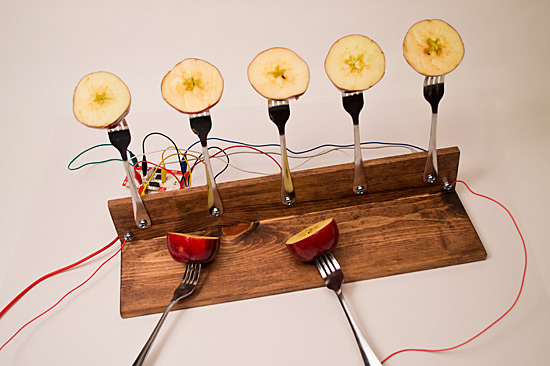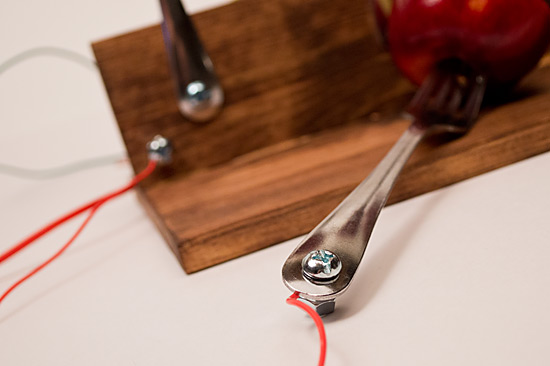A few months ago a bunch of us from Milwaukee Makerspace took part in Bay View Gallery Night, and jason set up the “Fruit Synthesizer” which was a Makey Makey with a variety of fruit, and some software combo of Max MSP and GarageBand. People really enjoyed it, and with the most recent Art Jamboree happening with jason out of town, I figured I would pick up the slack.
With a simple base made with two pieces of wood, some dollar store forks, a few nuts, bolts, and bits of wire, we had the Makey Makey Apple Piano.
One of the issues with jason’s Fruit Synthesizer was that you had to touch the fruit. He did provide hand sanitizer, but with it being flu season, having dozens of people touch a piece of fruit seemed like a bad idea, and forks just seemed like the right thing to keep hands clean, and work like xylophone mallets.
For a project like this it’s nice to have the controller board visible, so people can see it and you can easily explain how it works. The Makey Makey was sitting right behind the forky board thing.
The bolts that hold the forks in place also doubled as terminal connectors that I could attach the alligator clips to.
I added bolts at each end of the base for the ground connections. (And used red wires to match the Makey Makey, and the apples.)
The wires running to the forks serve two purposes: they ground the forks to complete the connection that the Makey Makey needs, and they also tether the forks to the base to keep it all together. (Drilling holes through the forks was a lot of fun. I had to assure my wife I did not drill holes in our everyday dining forks.)
But wait! You can’t just have a bunch of forks and apples and wires and expect something to happen… you also need a computer and some sort of software to do anything useful…

I wrote a Processing application to play sounds and light up the specific apple you were hitting. (I got a good start on the code from this sketch.) I had a lot of fun(!?) with the Minim library. My original plan was to export the Processing application as a Windows executable and use an old netbook to run it. That sort of worked, but I don’t know if the Windows XP machine was up to the task, because when I set it up at the event (after extensive testing in the lab) the audio freaked out, so I ended up switching to my MacBook. An Apple Computer controlled by Apples… fitting, right?
(Processing isn’t the greatest thing for this sort of task, and MIDI really is the right way to go, but we’re already planning our next Makey Makey Monstrosity, so expect some improvements.)
So did it work? It worked! People had a good time playing with it. Here’s a few photos…





Pro-tip for using apples: Keep some lemon juice on-hand! I gave the apples a squirt every now and then to keep them moist and prevent browning. Over the course of 4 hours I did have to change out the apples that were used as the mallets after they got a little mushy. Some people were really pounding on them!
Update: Here’s a short video of the first test of it.





















